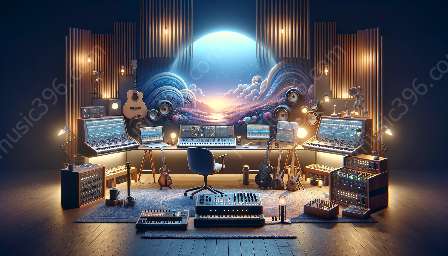In the world of film scoring, MIDI synchronization plays a vital role in connecting musical compositions with visual storytelling. This topic cluster covers the inner workings of MIDI synchronization and its compatibility with the film scoring process.
MIDI in Film Scoring
MIDI, which stands for Musical Instrument Digital Interface, has revolutionized the way music is created, recorded, and integrated into various media, including film. In film scoring, MIDI allows composers and musicians to generate, manipulate, and synchronize electronic musical performances with visual content, providing a versatile and efficient method for crafting and delivering high-quality music for film and television productions.
Understanding MIDI Synchronization
MIDI synchronization refers to the process of aligning musical events, such as tempo, timing, and cue points, within a MIDI composition to match the pacing and dynamics of the visual content in a film. This synchronization ensures that the music complements and enhances the emotional impact of the scenes, creating a cohesive and immersive cinematic experience for the audience.
MIDI Timecode (MTC) and MIDI Clock
Two fundamental elements of MIDI synchronization are MIDI Timecode (MTC) and MIDI Clock. MTC is a timing protocol that allows MIDI devices to follow the timeline of a film, enabling precise synchronization between the music and the visual elements. MIDI Clock, on the other hand, serves as a tempo reference, ensuring that the musical cues and tempo changes align seamlessly with the on-screen action.
Interactive MIDI Control
Another aspect of MIDI synchronization in film scoring involves interactive MIDI control, which allows composers and musicians to adapt the musical performance in real-time based on the evolving narrative and emotional dynamics of the film. This level of interactivity empowers creators to tailor the music to the specific nuances of each scene, generating a more organic and expressive musical accompaniment.
Benefits of MIDI Synchronization in Film Scoring
- Precision: MIDI synchronization enables precise alignment of musical cues with visual events, ensuring seamless integration and enhancing the overall impact of the film.
- Flexibility: By using MIDI synchronization, composers can easily experiment with different musical arrangements and tempos, adjusting them to perfectly match the changing moods and pacing of the film.
- Efficiency: MIDI streamlines the workflow for composing, recording, and editing music for film, offering a time-efficient and cost-effective solution for delivering high-quality soundtracks.
- Scalability: MIDI synchronization allows for scalable production, making it feasible to create complex musical compositions for large-scale film projects with ease.
Conclusion
In conclusion, MIDI synchronization plays a crucial role in the art of film scoring, providing a sophisticated framework for aligning musical elements with visual storytelling. Its compatibility with MIDI and musical instrument digital interface has revolutionized the way music is integrated into films, offering precision, flexibility, efficiency, and scalability to composers and musicians. Understanding the inner workings of MIDI synchronization is essential for anyone involved in the creative process of film scoring, as it opens up endless possibilities for crafting immersive and impactful soundtracks.


